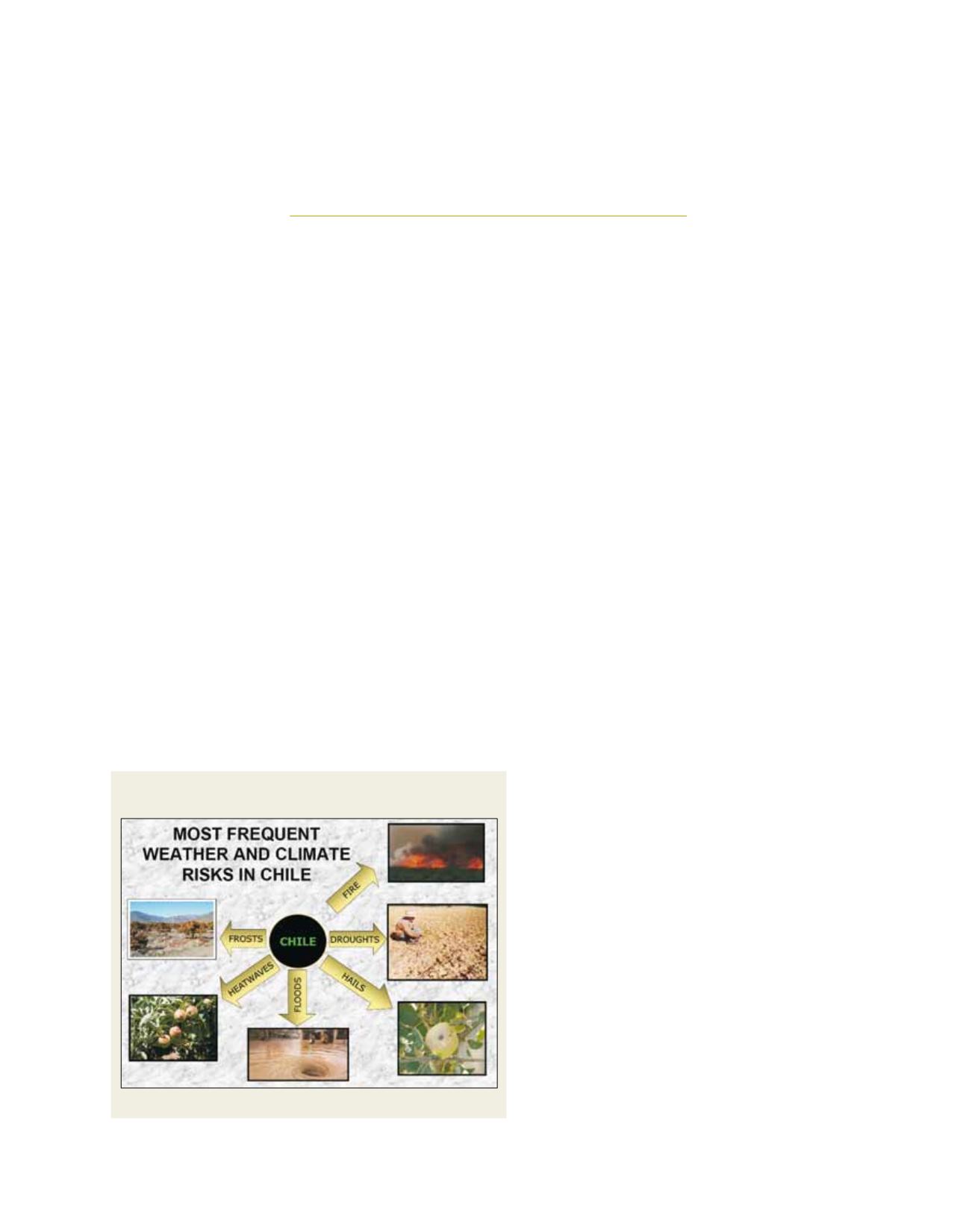

[
] 50
Seasonal climate prediction in Chile:
the Agroclimate Outlook
Juan Quintana, Benito Piuzzi and Jorge F. Carrasco, Dirección Meteorológica de Chile –
Dirección General Aeronáutica Civil; and Liliana Villanueva,
Ministerio de Agricultura, Unidad de Emergencia Agrícola
T
he Agroclimate Outlook is a monthly bulletin produced
by the Dirección Meteorológica de Chile (DMC) and freely
available in the organization’s website. It contains infor-
mation about the predicted seasonal climate conditions that
are most likely to prevail during the next three months. The
total precipitation accumulation and the average minimum
and maximum air temperatures for the three-month period are
predicted variables, which are considered for analysing and
predicting the implications in the agriculture sector. The seasonal
forecast is based on the correlation between the El Niño Southern
Oscillation (ENSO) and the predicted variables in Chile.
Agricultural meteorology deals with the relationship between
weather and climate and crop, livestock and soil management.
Agricultural activity carries implicit risks of diverse origins,
among which, are atmospheric factors. Generally speaking, these
factors can be weather- or climate-related, according to the dura-
tion of the meteorological event. Thus, phenomena that develop
and have a lifetime from a few hours to a week are considered
weather-related and their forecasts are produced at least on
a daily basis. On the other hand, there are other phenomena
A
griculture
whose genesis and duration involve longer periods
of time, from few weeks to months or even years.
These are considered climate-related and their fore-
casts are produced and disseminated on a monthly
basis. Weather or climate forecasts, regardless of their
characteristics, do not refer to or indicate the degree
of risk given by the prediction; they rather express
and inform users on the degree of likelihood that a
meteorological event can occur in a given time and
place. Atmospheric factors can have implications
on agriculture and related activities, and knowing
in advance how they will develop (forecasts) and
affect a region can help farmers and decision-makers
to take actions for mitigating or benefiting from the
predicted atmospheric conditions. For example, they
can receive information for better agriculture water
management, for planning periods of planting and
harvesting, for improving livestock management or
for altering grazing and rotation pastures.
The natural climate variability in Chile often results
in extreme meteorological events, such as droughts,
floods, cold waves (including frost), heat waves and
sometimes severe thunderstorms and hailstorms. These
extreme phenomena occur on different temporal and
spatial scales – thunderstorms and floods can last a few
hours, while frosts and droughts might last for days or
even months; and while some events might affect a small
area, others will be of synoptic scale, affecting a large
region. This variability is the result of natural processes
that, alone or combined with others, can develop an
atmospheric condition triggering and supporting the
occurrence of a meteorological event. For instance,
frost days are mostly caused by very cold air masses
moving behind a frontal band. Periods with little or no
precipitation during the winter, or a rainy period (three
to four weeks) in central Chile (30-40° south) can be
associated with atmospheric alterations caused by the
Madden-Julian Oscillation,
1
which is an intra-seasonal
climate variability that takes place in the equatorial
band of the Indic and western Pacific ocean region with
a recurrence period of 30-60 days. On the other hand,
under or above annual normal precipitation in Chile is
most likely associated with the inter-annual variabil-
ity caused by ENSO, which is an oceanic-atmospheric
Source: DMC
The most frequent weather and climate risks in Chile
















